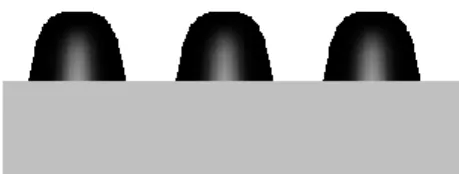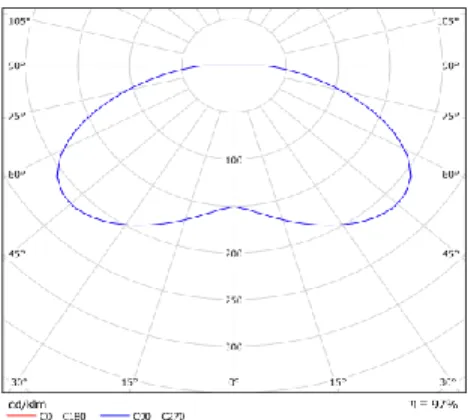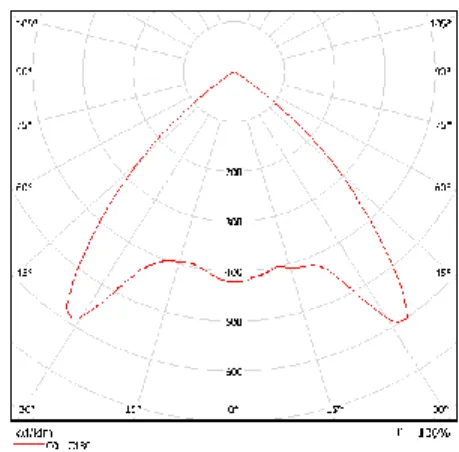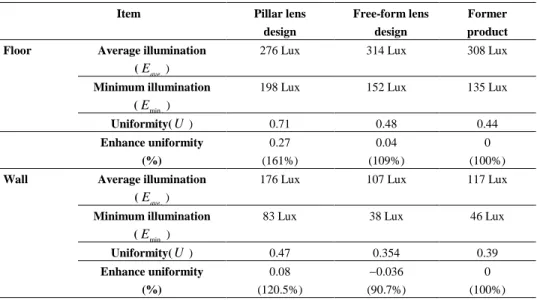Improvement of illumination uniformity for LED
flat panel light by using micro-secondary lens
array
Hsiao-Wen Lee1,* and Bor-Shyh Lin2,3,4
1Institute of Photonic System, National Chiao Tung University,Tainan, 71150 Taiwan, 2Institute of Imaging and Biomedical Photonics, National Chiao Tung University,Tainan, 71150, Taiwan 3Biomedical Electronics Translational Research Center, National Chiao Tung University, Hsin-Chu 30010, Taiwan
4Department of Medical Research, Chi Mei Medical Center, Tainan 71004, Taiwan *mars0409@gmail.com
Abstract: LED flat panel light is an innovative lighting product in recent years. However, current flat panel light products still contain some drawbacks, such as narrow lighting areas and hot spots. In this study, a micro-secondary lens array technique was proposed and applied for the design of the light guide surface to improve the illumination uniformity. By using the micro-secondary lens array, the candela distribution of the LED flat panel light can be adjusted to similar to batwing distribution to improve the illumination uniformity. The experimental results show that the enhancement of the floor illumination uniformity is about 61%, and that of the wall illumination uniformity is about 20.5%.
©2012 Optical Society of America
OCIS codes: (220.2945) Illumination design; (230.3670) Light-emitting diodes; (080.4298)
Nonimaging optics; (350.4600) Optical engineering; (080.4295) Nonimaging optical systems.
References and links
1. C. H. Tsuei, J. W. Pen, and W. S. Sun, “Simulating the illuminance and the efficiency of the LED and fluorescent lights used in indoor lighting design,” Opt. Express 16(23), 18692–18701 (2008).
2. H. Ries and A. Rabl, “Edge-ray principle of nonimaging optics,” J. Opt. Soc. Am. A 11(10), 2627–2632 (1994). 3. P. A. Davies, “Edge-ray principle of nonimaging optics,” J. Opt. Soc. Am. A 11(4), 1256–1259 (1994). 4. L. Sun, S. Jin, and S. Cen, “Free-form microlens for illumination applications,” Appl. Opt. 48(29), 5520–5527
(2009).
5. T. C. Teng and M. F. Kuo, “Highly precise optical model for simulating light guide plate using LED light source,” Opt. Express 18(21), 22208–22214 (2010).
6. G. Kochanski, “Monte Carlo simulation,” http://kochanski.org/gpk
1. Introduction
With the growth of LED optical efficiency, many innovative products in the traditional lighting industry were developed rapidly. However, it is well known that LED lighting products are usually directive light sources. Thus, they are still not completely fit to the whole indoor lighting market due to some parts of indoor lighting market require isotropic lighting products. In 2008, Tsuei et al. proposed a new optical design for LED indoor lighting product, which can provide better illumination uniformity than traditional t-bar fluorescents, and the efficiency of the illumination uniformity could be enhanced effectively [1]. Recently, a new LED lighting product, named flat panel light, was proposed and applied in home lighting or office lighting. Current flat panel lights are usually designed by using edge-lit backlight theorem, and they contain several advantages, such as the thinner volume and the more uniform brightness of emitting surface. But they also contain some drawbacks, such as narrow lighting areas and hot
spots. The narrow lighting area usually results from the directive light source of the LED package, and it also easily forms hot spots in the lighting space.
In this study, an innovative optical design approach was proposed to enhance illumination uniformity. Here, the micro-secondary lens array technique was applied for the design of the light guide surface to enhance the illumination uniformity. The micro-secondary lens array can be used to readjust the light intensity in each angle. By using the micro-secondary lens array, the candela distribution of the flat panel light can be adjusted as the batwing distribution, and therefore, its illumination uniformity in the lighting space can be efficiently improved.
Fig. 1. Enlarged picture of the micro- secondary lens array on the light guide surface.
2. Methods
2.1 Micro-secondary lens array design on the light guide surface
The optical design of flat panel lights is usually based on the designer’s past design experience on light guide, reflector and diffuser. In this study, the micro-secondary lens array technique was applied for the emitting surface design of the flat panel light guide to improve the illumination uniformity. The micro-secondary lens array can be used to readjust the light intensity in each angle of the flat panel light. Therefore, we attempted to adjust the candela distribution of the flat panel light similar to the batwing distribution. Figure 1 shows the enlarged picture of the micro-secondary lens array on the light guide surface, and it is a kind of divergent and uniform lens.
2.2 The optical invariant for micro-secondary lens
An optical system does not change the phase-space volume, also known as etendue, of the ray passing through it [2–4]. Figure 2 illustrates the optical model for a ray passing through a single micro-lens. Here, we hope the radiations of the source1 and source2 arrive at the target surface. And the flat surface of the micro-lens results in total reflection. According to energy conservation law, the final power of uniformity illumination on the target surface can be expressed as 1 , i N f i total i A C E ds E ds E
(1)where A denotes the area of uniform illumination on the target surface, Ef is the luminance on the target surface,N is the quantity of the cells on the panel plane, Ciis the area of the cell,
i
E is the luminance of the uniform collimated radiation passing through the cellCi , and total
E is the total energy of radiation from the source1 and source2 [10].
2.3 Design concept of batwing candela distribution
The design of flat panel lights is generally based on LCD edge-lit backlight theorem [5]. General flat panel lights can provide nearly uniform luminance, but actually, their illuminations are still not uniform enough. Therefore, in this study, we attempted to redesign the flat panel light by readjusting the luminous intensity in each angle. The candela distribution of the proposed flat panel light design will be similar to a batwing distribution, which can provide more uniform illumination on the floor. Here, we defined the performance of illumination uniformity as the ratio of the average illumination and minimum illumination, and its formula is given as follows.
min./ ave.,
U E E (2)
where U denotes the performance of illumination uniformity, and Emin . and Eave. denote the minimum illumination and average illumination respectively.
2.4 Ray tracing method
The optical system was simulated by Monte Carlo method. Monte Carlo method is a technique that involves using random numbers and probability to solve problems, and is usually applied for complex and nonlinear models, and the problems which involve more than just a couple uncertain parameters. It is a class of computational algorithms that rely on repeated random sampling to simulate ray tracing, and can provide faster simulation performance than other computational algorithms, such as FDTD method, et al. However, its drawback is that it may result in incorrect results if the number of rays is insufficient [6].
Fig. 4. Side view picture for the ray traces of the proposed flat panel light.
Fig. 5. Top view picture for the ray traces of the proposed pillar lens of flat panel light.
3. Optical simulations
3.1 Micro-secondary lens array design for LED flat panel light
Design 1:Pillar Lens
The optical system of the flat panel light redesigned by using lens array technology was simulated by Monte Carlo method. Figure 3 shows the optical system of the flat panel light. Figure 4 and Fig. 5 are the side view and the top view pictures for the ray traces of the proposed light guide respectively. The most rays will be refracted from surface 1 and 3. It can adjust the optical axis angle of surface 1 and 3 by design surface curvature, to realize the batwing distribution of flat panel light. The pillar lens dimension is less than 1 millimeter and its aspect ratio is almost 1:1. The pillar lens is made of pmma, which can provide better transmittance than polycarbonate. The top view of the pillar lens is a quadrilateral form. And there is the same optical distribution with parallel lamp sides.
Fig. 7. Side view picture of the proposed free form lens for ray tracing.
Fig. 8. Top view picture of the proposed free form lens for ray tracing.
Design 2:Free-form Lens
The shape of the free form lens is similarly cylindrical. The lens diameter is less than 2 millimeter and its height is 1.5 millimeter. The free form lens is also made of pmma. The free form lens can provide better injection performance than the pillar lens due to its high-symmetrically cylindrical shape. However, it may also cause serious vagabond ray. The rays from surface 1 and surface 3 easily enter other free form lens. Although the optical efficiency of free form lens is lower than that of pillar lens, it can improve illumination uniformity effectively. Figure 6 shows the free-form lens of the flat panel light optical system. Figure 7 and Fig. 8 are the free-form lens side view and top view picture of the free-form lens for ray tracing.
Table 1. Computer classroom space dimension
Computer classroom space dimension Length 12 m Width 9.5 m Area 114m2 Ceiling height 2.8 m
Work plane height from floor 0.7 m
Luminaire height from floor 2.8 m
Lamp distance 2.4 m
Wall Reflection coefficient 50%
Floor Reflection coefficient 20%
Ceiling Reflection coefficient 70%
Desk surface Reflection coefficient 50%
LED flat panel light Lumen 3800 Lm
Fig. 9. Candela distribution of commercial flat panel lights.
Fig. 10. Pseudo-color performance of general flat panel lights in a computer classroom space.
3.2 Simulation for the space lighting of LED flat panel lights
(a) Space lighting simulation of commercial flat panel lights
The candela distributions of current flat panel lights are usually not uniform enough due to that their view angles are almost more than 70% lumen focused on the view angle. Table 1 shows the space dimension of a computer classroom, reflection coefficients for different materials, and the illumination specification of commercial LED flat panel light. Here, the flat panel lights with the size of 60 cm x 60 cm were used in this computer room, and their candela distribution is shown in Fig. 9. The general office lighting design is setting a lamp spacing 1.8 meter. We hope to improve the indoor lighting efficiency, and then reduce the number of lamps and energy consumption. Therefore, in this study, the arrangement of lamp is setting a lamp spacing 2.4 meter. Here, the space lighting efficiency was simulated by Dialux. It obviously shows that the space lighting efficiency depends on the lamp’s candela distribution and the space dimension of the computer room. The main and maximum illumination was focused in the center, and almost rays were concentrated in the bottom of the lamps. Figure 10 and Fig. 11 show the pseudo-color performance and grayscale performance of commercial flat panel lights in a computer room respectively. It shows that the illumination in the bottom of the lamp and near the center of the computer room is significantly strong than other areas. The difference between the he maximum illumination and the average illumination around the center of the computer room is even larger than 500 Lux. Therefore, the space lighting performance is obviously non-uniform, and there are many dark areas around the corner and the wall of the computer classroom.
Fig. 13. Pseudo-color performance of the pillar lens’ flat panel lights in a computer classroom space.
Fig. 14. Grayscale performance of the pillar lens’ flat panel lights in a computer classroom space.
(b) Space lighting simulation of the redesigned flat panel light Design 1:Pillar Lens
The light guide surface was redesigned by applying micro-secondary lens array. The illumination uniformity in the space lighting can be effectively enhanced by adjusting the curvature of lens, and the curvature was set less than 1mm. By readjusting the intensity in each angle, the candela distribution of the redesigned flat panel light is shown in Fig. 12. Here, the boundary condition of the computer classroom space dimension is also referenced to Table 1. Figure 13 and Fig. 14 show the pseudo-color performance and grayscale performance of the redesigned flat panel light in the computer room respectively. Obviously, the illumination uniformity of the redesigned flat panel light is better than that of commercial flat panel lights. The difference between the maximum and the average illumination around the center of the computer room is only about 150 Lux, and that around the wall of the computer classroom is less 100 Lux.
Fig. 15. Candela distribution of the free form lens design.
Fig. 16. Pseudo-color performance of the free-form flat panel lights in a computer classroom space.
Design 2:Free-form Lens
The optical system of the flat panel light was designed by free-form curvature lens. The far-field distribution of the free-form lens, shown as Fig. 15, is a batwing distribution, and can enhance the illumination uniformity on the image plan. By the narrow view angle property of the candela distribution, the average illumination of the free-form lens on the floor is better than that of pillar lens and former flat panel lights. The uniformity of the free-form lens is better than that of former flat panel lights, but is worse than that of pillar lens. The proposed free-form lens can enhance the average illumination on the floor. Therefore, it is suitable for high illumination space design, but is not suitable for soft illumination space design. Figure 16 and Fig. 17 are the pseudo-color performance and grayscale performance of the free-form flat panel lights in the computer classroom space.
Table 2. Performance comparison between the proposed and the commercial flat panel light products
Item Pillar lens
design
Free-form lens design
Former product Floor Average illumination
(Eave.)
276 Lux 314 Lux 308 Lux
Minimum illumination (Emin .)
198 Lux 152 Lux 135 Lux
Uniformity(U) 0.71 0.48 0.44 Enhance uniformity (%) 0.27 (161%) 0.04 (109%) 0 (100%)
Wall Average illumination (Eave.)
176 Lux 107 Lux 117 Lux
Minimum illumination (Emin .)
83 Lux 38 Lux 46 Lux
Uniformity(U) 0.47 0.354 0.39 Enhance uniformity (%) 0.08 (120.5%) 0.036 (90.7%) 0 (100%) 4. Experimental results
The light guide design is an important optical component of LED flat panel light, and it also affects the performance of the illumination uniformity. However, the light guide design of current flat panel light is still not perfect, in particular, for the view angle and intensity distribution in each angle. The light guide was redesigned by using micro-secondary lens array technique to improve the illumination uniformity, and the IES files of the proposed and a commercial LED flat panel lights were imported into the computer classroom model for space lighting simulation. Table 2 shows the performances of the proposed and the commercial flat panel lights in a computer classroom. The performance of illumination uniformity on the floor and wall were compared. The enhancement of the illumination uniformity on the floor and the wall are about 61% and 20.5% respectively. If the illumination of on the floor and wall is more uniform, the space lighting in the classroom will become softer.
5. Conclusion
In this study, the light guide surface was redesigned by using secondary lens array technique to improve the illumination uniformity. The candela distribution of the proposed flat panel light
floor and wall are about 61% and 20.5% respectively. The proposed optical design of flat panel lights really can provide more uniform brightness on the surface of computer monitors and reduce the dark area in the ceiling corner effectively.








